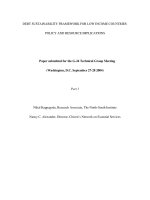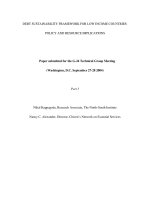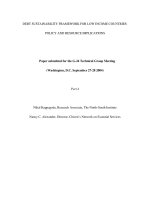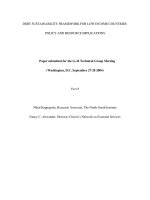DEBT SUSTAINABILITY FRAMEWORK FOR LOW INCOME COUNTRIES : POLICY AND RESOURCE IMPLICATIONS - Part 3
Bạn đang xem bản rút gọn của tài liệu. Xem và tải ngay bản đầy đủ của tài liệu tại đây (37.92 KB, 9 trang )
DEBT SUSTAINABILITY FRAMEWORK FOR LOW INCOME COUNTRIES:
POLICY AND RESOURCE IMPLICATIONS
Paper submitted for the G-24 Technical Group Meeting
(Washington, D.C. September 27-28 2004)
Part 3
Nihal Kappagoda, Research Associate, The North-South Institute
Nancy C. Alexander, Director, Citizen’s Network on Essential Services
Debt Sustainability Framework
1. Unlike in the HIPC Initiative where a single indicator – debt to exports -
was used the DSF paper selects three debt ratios to judge debt
sustainability. Further, country policies and institutional capability and
vulnerability to shocks are other factors identified as being important for
assessing a country’s debt sustainability. In particular, country policies
and institutional capability are used to grade countries and determine
different debt ratio thresholds for them.
1
2. As stated, under the proposal, debt sustainability will become a key
factor for allocating grants under IDA 14. The international community
has also made it a central concern in other multilateral development
banks where replenishment negotiations are under way. Following
Board approval of the broad principles of the framework paper, the IDA
paper
2
developed the framework into a practical system for allocating
grants under IDA 14 based on those aspects of the framework on which
there has been international agreement and on which adequate research
work has been done. It is necessary to reiterate that the principal
objective of the framework is to assist low-income countries maintain
sustainable debt levels and reduce the risk to IDA of debt problems in
the countries in which IDA will provide a significant share of financing
under IDA 14 and later.
1
These multiple factors were identified in the paper “When is External Debt Sustainable?” by Aart Kray
and Vikram Nehru, Policy Research Working Paper 3200, The World Bank, February 2004.
2
Ibid footnote 3.
3. The proposed grant allocation system in IDA 14 will be based on two
pillars. The first is the debt distress thresholds of the selected indicators
for the groups of countries that are classified as strong, medium and
poor performers based on the CPIAs
3
. The second is projected levels of
the selected debt indicators that take account of the impact of exogenous
shocks to the extent these can be forecast in the country DSAs. The
results of these will then be used to allocate a share which is 0, 50 or
100 percent of the allocation that will be made under IDA 14 as grants.
It should be noted that the CPIA has an influence in determining the
overall level of IDA funds to a country as well as the debt thresholds
that will be applicable to it.
Debt Distress
4. Debt distress is typically associated with (a) the accumulation of arrears
on external debt service payments exceeding five percent of the external
debt outstanding; (b) an application to the Paris Club for debt
restructuring of official debt when a breakdown in the payments system
is judged to be imminent; and (c) the country concerned has entered into
a Standby or Extended Fund Facility Agreement with the IMF which is
sine qua non for the Paris Club to proceed with discussions on debt
restructuring.
3
CPIAs are discussed in greater detail later in the paper.
5. While these are the external manifestations of a debt crisis, as stated
earlier, there are three main causes of debt distress. The first is a high
level of debt judged by the absolute amount or PV of debt outstanding
as a ratio with GDP, exports or government revenue. The second is a
weak institutional and policy environment in the country which makes it
probable for such countries to experience debt distress at lower debt
ratios than those with a strong environment. This is because of the
greater probability of “misuse and mismanagement of funds” and the
limited capability to use resources in a productive manner. The third is
external shocks to the economic system that affect the country’s
capacity to service its debt without compromising its long-term
development goals.
6. In the paper written by Kray and Nehru
4
the level of probability of
experiencing debt distress that borrowers seem willing to tolerate was
identified as 25 percent based on the experience of countries in their
sample. Thereafter debt thresholds dependent on the country’s policies
and institutions measured by the CPIA
5
were derived. A distress
probability of 25 percent
6
means that there is a 75 percent chance that
none of the chosen indicators of debt distress would exceed the
thresholds in the next five years. On the other hand, there is a 25
percent chance that at least one of the indicators of debt distress will
4
Ibid footnote 6.
5
A higher probability permits a higher threshold for debt though at the risk of future debt distress. Thus
the probability of debt distress and the debt thresholds for the chosen indicators are policy decisions that
need to be made.
6
Footnote 19 in “Debt Sustainability in Low Income Countries” by Mark Allen and Gobind Nankani,
World Bank and IMF, February 2004.
exceed the threshold in the next year and will continue to do so for at
least three years. The table below sets out the debt thresholds for the
chosen indicators of countries with poor, medium and strong
institutional capabilities and quality of policies with the cut offs at the
25
th
, 50
th
and 75
th
percentiles of the CPIA index ranked in ascending
order. The CPIA for each country as described below will be the
average ranking of all the indicators in the index marked from a low of
1 to a high of 6. Accordingly, the CPIA for the 25
th
percentile was
estimated to be 2.9 and 3.6 for the 75
th
percentile. Thus poor performers
from the point of view of institutional strength and quality of policies
are those with a CPIA of less than 2.9, those judged to be medium
performers have their CPIAs in the range of 2.9 to 3.6 percent while
those of strong performers exceed 3.6.
Table 1
Thresholds for Debt Indicators based on Institutional Strength and
Quality of Policies
7
Debt Indicator Strong Medium Poor
NPV of debt/GDP 60 45 30
NPV of debt/Exports 300 200 100
7
Ibid footnote 2.









